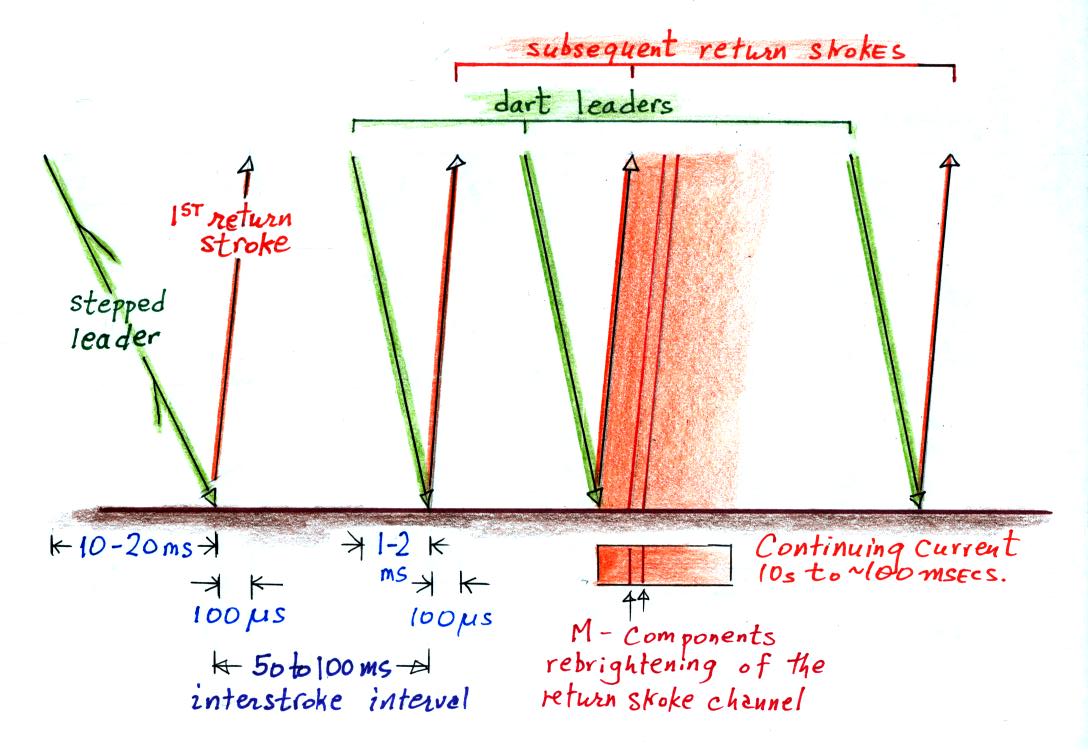
The discharge begins at left in the figure with a branched stepped leader that is followed by a 1st return stroke. The stepped leader takes a few 10s of milliseconds to travel from the main negative charge center in the cloud to the ground. The ensuing 1st return stroke travels back up the channel to the cloud is about 100 microseconds.
Then, with a few slight differences, the process repeats itself. Additional discharges occur typically at intervals of 50 to 100 ms and are usually preceded by a dart leader that travels, without stepping or branching, down the existing main channel. A short upward connecting discharge is initiated when the dart leader gets close to the ground and then a subsequent return stroke travels back up the channel to the cloud. We'll look at the dart leader and subsequent return stroke processes in a little more detail shortly.
The 3rd return stroke in the illustration above is following by a continuing current. This is a low amplitude (100s of Amperes) current that continues to flow for 10s of milliseconds or more typically, which keeps the return stroke channel luminous. Short rebrightenings of the channel sometimes occur during the continuing current, these are called M-components.
The bright flashes of light produced by multiple return strokes produces the flickering that you sometimes sees when observing cloud to ground lightning. If you deliberately move a camera back and forth while photographing lightning the separate strokes will be displaced on the image. The technique is described in an article "Panning for Lightning," by John Hendry Jr. that was published in Weatherwise Magazine (vol. 45, No. 6, pps 18-19, Dec. 1992/Jan 1993 issue). Here is an example (source: http://www.odec.ca/projects/2005/schu5s0/public_html/lightning.html ).
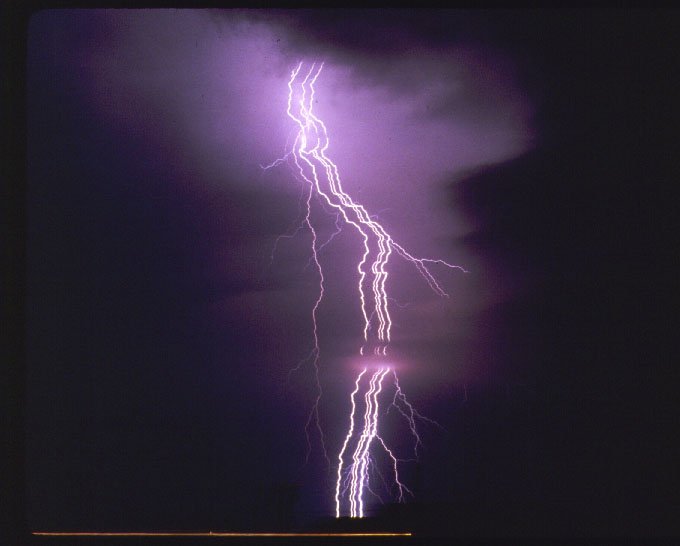
This appears to have been a 4 stroke flash. The rightmost channel in the photograph is branched so that is the first return stroke. Separation of the return strokes channels like this can sometimes be caused by wind. That is referred to as "ribbon lightning." As long as we're on the subject of lightning photograph, here is a good lightning photograph guide.
Manual movement of the camera is sufficient to time resolve the separate strokes in a lightning flash. Here's a short description of the Boys Camera that was used originally to photograph the sequences of processes in cloud-to-ground lightning with much faster time resolution (source: Lightning, Martin A. Uman, Dover Publications, New York, 1984)
Now some more information about dart leaders and subsequent return strokes.
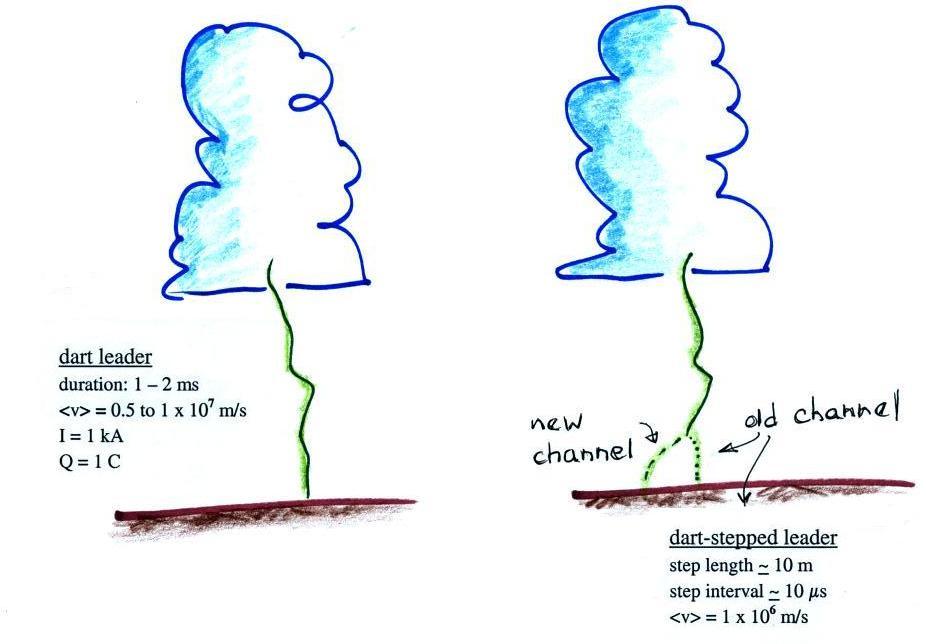
Because a dart leader is following an existing channel it travels faster than a stepped leader.
Sometimes the dart leader will depart from the existing channel and form a new channel to ground. Because it is traveling through air that hasn't been ionized, the lower portion of the dart leader would turn into a stepped leader.
Occasionally there is sufficient time between strokes that the existing channel can begin to cool and become less conductive. Under these conditions the dart leader becomes a dart-stepped leader. The steps of a dart-stepped leader are shorter and occur more frequently than a stepped leader.
Some subsequent return stroke characteristics are summarized in the table below
| peak current |
10 kA |
| peak current derivative |
100 kA/μs |
| velocity |
1 x 108 m/s |
Statistics on the number of strokes per flash are shown in the following two histograms (source: Lightning: Physics and Effects, V.A. Rakov, M.A. Uman, Cambridge Univ. Press, Cambridge, 2003).
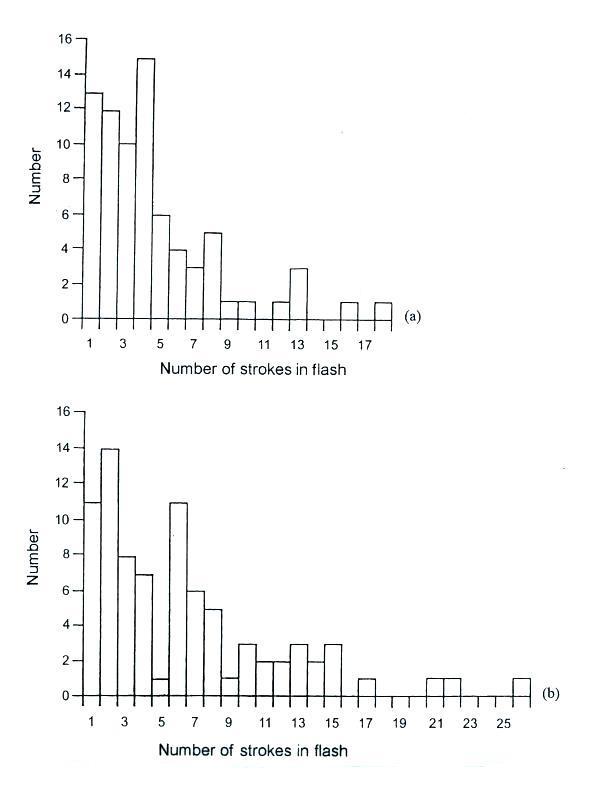
Many lightning parameters or characteristics are log-normally distributed. This appears to be the case with the interval time between return strokes distribution in the next figure (also from the Lightning: Physics and Effects source mentioned above)
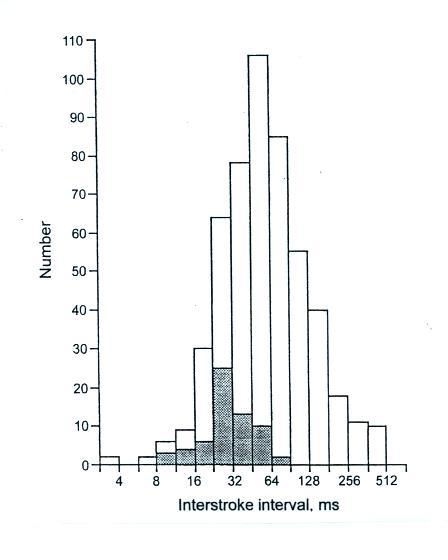
Up to now we really haven't considered the possibility that dart leaders and subsequent return strokes might depart from the channel created by the stepped leader and 1st return strokes. That does often turn out to be the case. This means that the separate strokes in a flash do not always strike the same point on the ground. The illustration and statistics below come from "Statistics and characteristics of cloud-to-ground lightning with multiple ground contacts," W.C. Valine and E.P. Krider, J. Geophys. Res., 107(D20), 4441, doi:10.1029/2001JD001360, 2002).
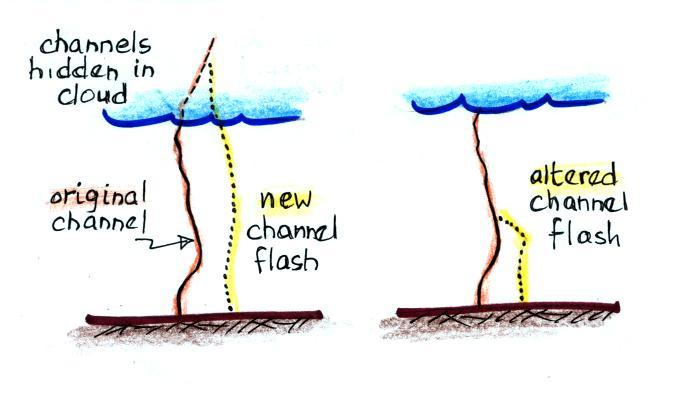
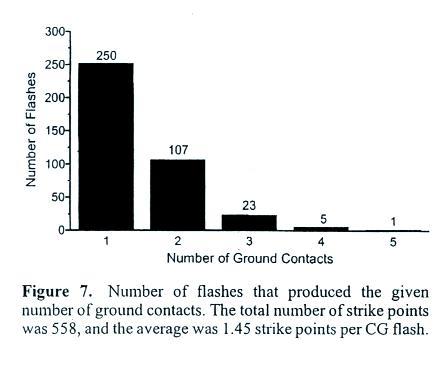
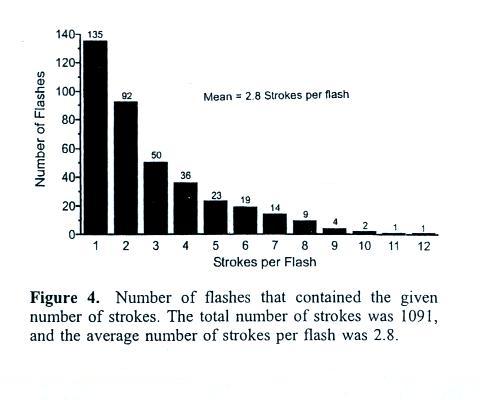
Next we look at how a multi-stroke
cloud-to-ground discharge might
appear on slow and fast electric field antenna records.
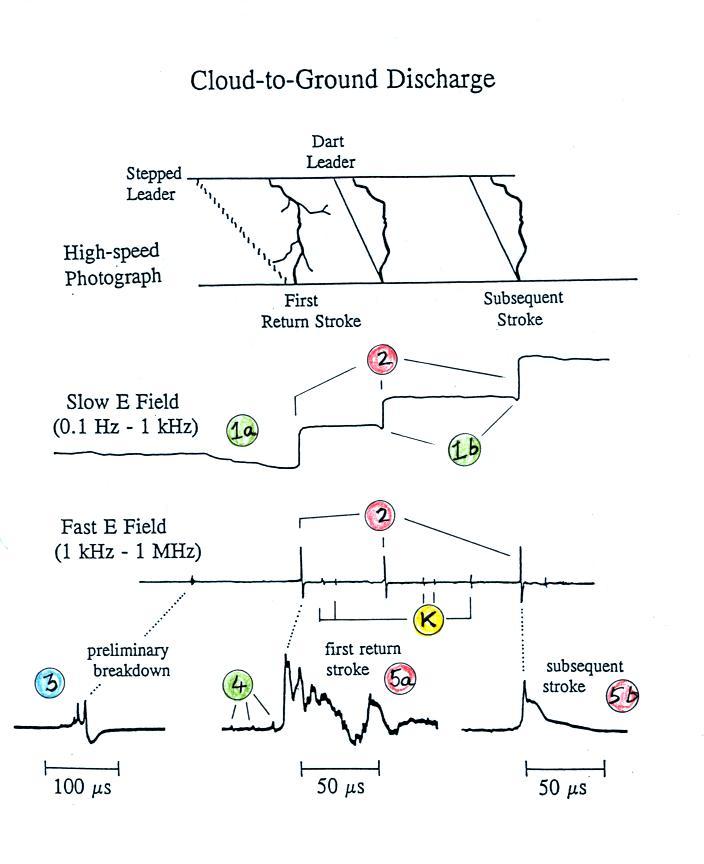
The sequence of events shown on the sketch of a high-speed photograph record of a discharge at the top of the figure should be familiar by now.
Point 1a on the slow E field record shows the field change produced by the stepped leader (the E field at the ground points upward toward the negative charge being lowered by the leader, so it looks like the atmospheric electricity convention for E field polarity is being used on this figure). The dart leader field changes are shown at Points 1b. They are smaller in amplitude (the dart leader doesn't lower as much charge as the stepped leader) and have shorter durations.
The abrupt return stroke changes are shown at Points 2 on the slow E and the fast E records. Note one the slow E field record that the leader and return stroke field changes are of opposite polarity. The return stroke removes negative charge from the leader channel, charge that came from the main negative charge center in the thundercloud. The overall effect is the same as if a quantity of positive charge had been added to the cloud and used to neutralize the negative charge.
Points K on the fast E field record are "K changes." During the interval between return strokes, in-cloud leader processes seek out additional pockets of charge in the cloud. Occasionally, when the leader finds a concentration of charge, a rapid recoil streamer travels back along the in-cloud leader channel (in some ways like a return stroke propagates back along the leader in a cloud-to-ground strike). The K changes are probably produced by these recoil streamers.
The preliminary discharge process that initiates cloud-to-ground discharges is not well understood. Sequences of bipolar waveforms like shown at Point 3 though are thought to be associated with the preliminary breakdown process.
Point 4 shows E field pulses thought to be produced by the last few steps of the stepped leader as it approaches the ground.
The fast E field waveforms produced by 1st and subsequent strokes are distinctly different. The 1st return stroke field variations following the peak are considerably noisier than is observed with subsequent strokes. Some of the "noise" on the 1st return stroke E field record is probably produced by branches. Some of the structure on both the 1st and subsequent stroke waveforms is probably due to channel tortuosity.
Some of the modern lightning detection and location instrumentation is able to distinquish between return stroke waveforms and waveforms produced by leaders or discharges that occur during the preliminary breakdown activity.
The next figure is essentially the same except that some continuing current has been added following the second stroke.
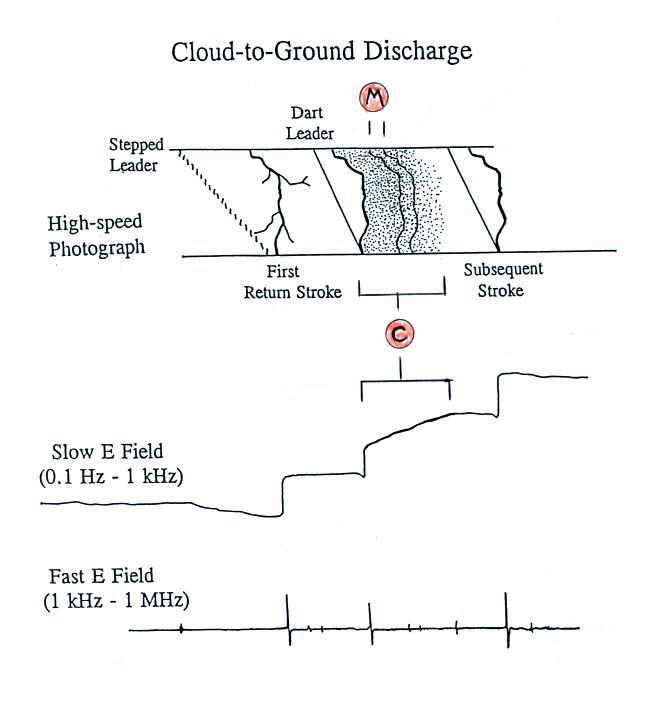
A continuing current is a low level current (10s to 100s of
Amperes) that continues to flow after a return stroke for 10s to a few
100s of milliseconds. The continuing current can transport
signficant quantities of charge to the ground (100 ms x 250 Amps = 25 C
). Continuing currents can burn through metal sheets or metal
skins on aircraft bodies. A CG lightning discharge with
continuing current is sometimes referred to as "hot lightning" because
these discharges are more likely to cause a forest fire than a
discharge without continuing current. A field change associated
with the continuing current is visible on the slow E field
record. M components are a rebrightening of the lightning channel
that occurs during a continuing current. The K changes seen on
the fast E field trace may be associated with the M components.
The next figure illustrates a triggered lightning discharge. The figure shows a typical slow E field record and a record of the current that would be measured at the ground instead of a fast E field waveform.
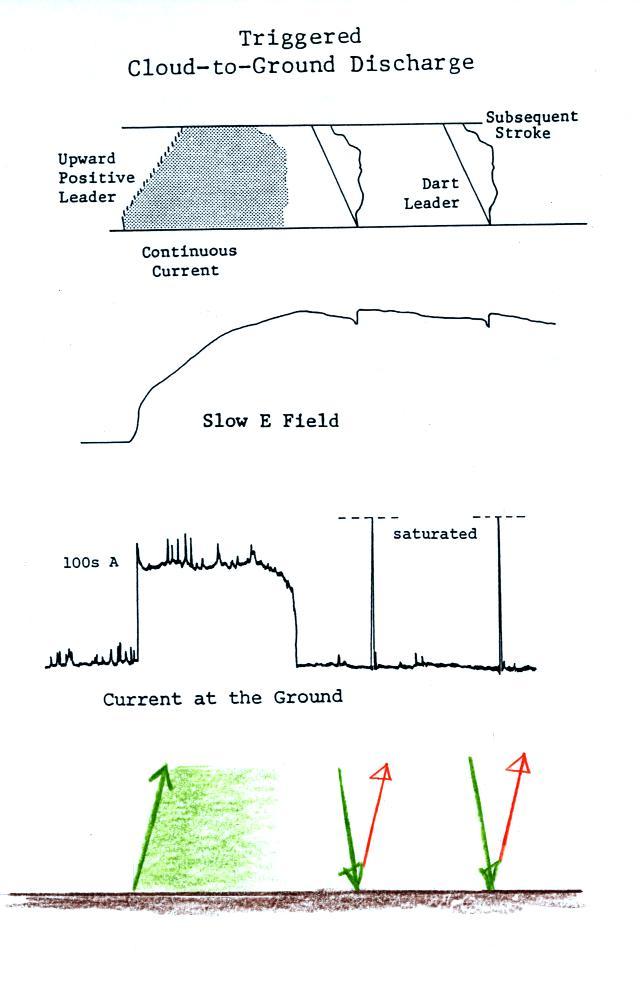

The sequence of events shown on the sketch of a high-speed photograph record of a discharge at the top of the figure should be familiar by now.
Point 1a on the slow E field record shows the field change produced by the stepped leader (the E field at the ground points upward toward the negative charge being lowered by the leader, so it looks like the atmospheric electricity convention for E field polarity is being used on this figure). The dart leader field changes are shown at Points 1b. They are smaller in amplitude (the dart leader doesn't lower as much charge as the stepped leader) and have shorter durations.
The abrupt return stroke changes are shown at Points 2 on the slow E and the fast E records. Note one the slow E field record that the leader and return stroke field changes are of opposite polarity. The return stroke removes negative charge from the leader channel, charge that came from the main negative charge center in the thundercloud. The overall effect is the same as if a quantity of positive charge had been added to the cloud and used to neutralize the negative charge.
Points K on the fast E field record are "K changes." During the interval between return strokes, in-cloud leader processes seek out additional pockets of charge in the cloud. Occasionally, when the leader finds a concentration of charge, a rapid recoil streamer travels back along the in-cloud leader channel (in some ways like a return stroke propagates back along the leader in a cloud-to-ground strike). The K changes are probably produced by these recoil streamers.
The preliminary discharge process that initiates cloud-to-ground discharges is not well understood. Sequences of bipolar waveforms like shown at Point 3 though are thought to be associated with the preliminary breakdown process.
Point 4 shows E field pulses thought to be produced by the last few steps of the stepped leader as it approaches the ground.
The fast E field waveforms produced by 1st and subsequent strokes are distinctly different. The 1st return stroke field variations following the peak are considerably noisier than is observed with subsequent strokes. Some of the "noise" on the 1st return stroke E field record is probably produced by branches. Some of the structure on both the 1st and subsequent stroke waveforms is probably due to channel tortuosity.
Some of the modern lightning detection and location instrumentation is able to distinquish between return stroke waveforms and waveforms produced by leaders or discharges that occur during the preliminary breakdown activity.
The next figure is essentially the same except that some continuing current has been added following the second stroke.

The next figure illustrates a triggered lightning discharge. The figure shows a typical slow E field record and a record of the current that would be measured at the ground instead of a fast E field waveform.

Triggered discharges are initiated
by an upward propagating, positively charged leader which is followed
by a continuous current. This is followed by downward moving,
negatively charged dart leaders and subsequent return strokes.
The dart leaders and subsequent strokes are thought to be similar to
those that occur in natural CG discharges.
And here are several links with more information and videos of triggered lightning.
Lightning research group at the University of Florida
UF Florida site at Camp Blanding
Longer compilation from Florida (and Langmuir Lab in New Mexico?)
And here are several links with more information and videos of triggered lightning.
Lightning research group at the University of Florida
UF Florida site at Camp Blanding
Longer compilation from Florida (and Langmuir Lab in New Mexico?)